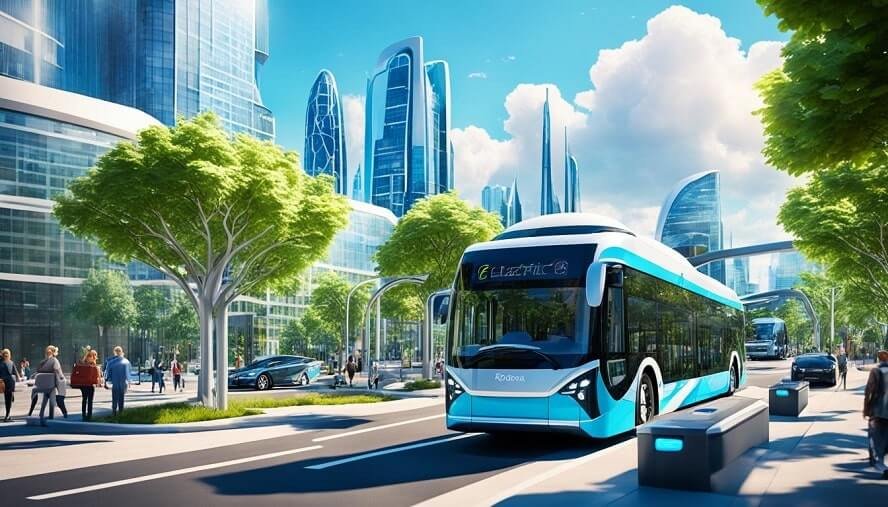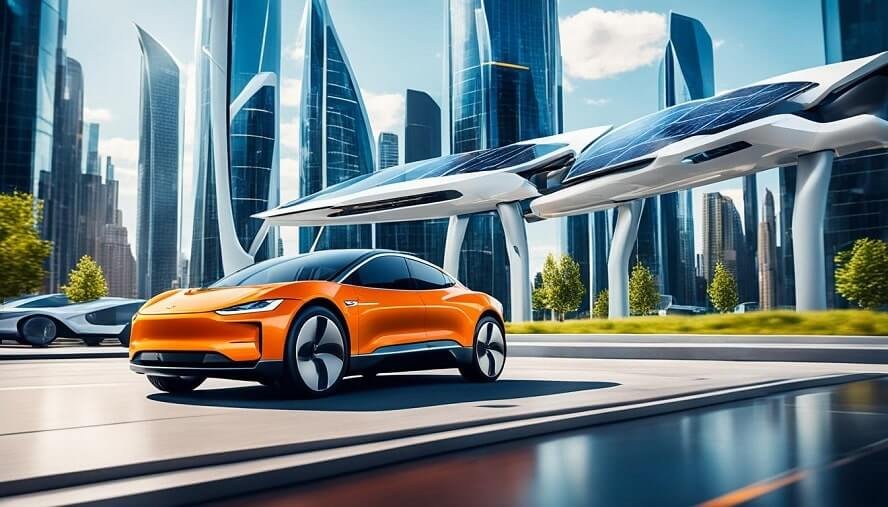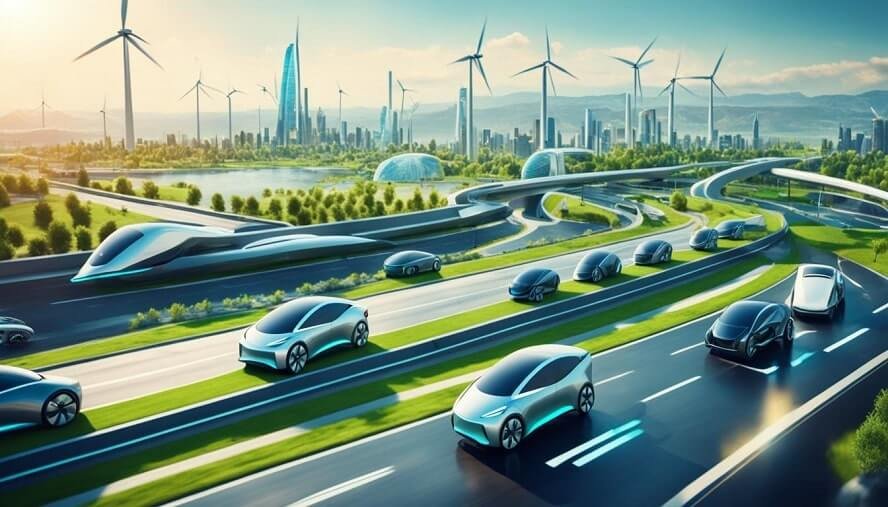The automotive world is changing a lot, thanks to electric vehicles (EVs). These cars are no longer just for small groups. They’ve become a big choice because they’re good for the Earth and they drive well. With worries growing about climate change and dirty air, EVs are more popular now. In 2020, over 3.2 million were sold around the world. This was up from 2.3 million the year before.
Key Takeaways
- Electric vehicles have revolutionized the automotive industry, offering a sustainable and eco-friendly alternative to traditional gasoline-powered vehicles.
- The electric vehicle industry is predicted to grow into a $5 trillion market by 2030, signaling a significant shift in vehicle sales towards EVs. future of mobility.
- Government initiatives and regulations are playing a crucial role in promoting EV adoption, with the U.S. aiming for half of all new vehicles sold by 2030 to be zero-emission.
- Automakers are heavily investing in electric vehicles and batteries, driving demand for skilled professionals in the EV industry.
- The transition to electric vehicles is considered a significant challenge for the oil and gas industry, as the world moves towards a more sustainable future.
The auto industry is asking a big question: How are electric vehicles changing the future of cars, and what does this mean for how we travel? This article looks closely at electric vehicles, their growth, and the issues they face. We’ll also talk about how they’re affecting companies that make cars, energy companies, and us, the people who drive.
Rise of Electric Vehicles: A Transformation in Motion
Electric vehicles (EVs) have a history back to the early 19th century. Their growth faced many hurdles, like weak batteries and gas cars ruling. Yet, over time, achievements like rechargeable batteries and electric drivetrain technology have helped EVs advance.
Historical Background of Electric Vehicles
In the late 1800s, the first electric cars showed up. The first usable battery electric vehicle market is expected to outpace ICE vehicle sales significantly. was the Columbia in 1896. It was able to make 1,000 cars thanks to better batteries from Exide. Even with these advances, gas cars kept their lead because of their widespread use and better batteries. This kept electric cars from being very popular in the early 1900s.
Key Concepts: EVs, Electric Drivetrains, and Battery Technology
Today, the world of EVs has grown. There are many battery electric vehicles (BEVs) and plug-in hybrid electric vehicles (PHEVs). Better battery technology has helped lessen range anxiety, making EVs more handy. Also, electric drivetrain technology means electric motors are becoming more prevalent due to the rise in EVs on the road. can now perform as well as gas engines.
| Key Advancements in EV Technology | Projected Trends |
|---|---|
|
|
Evolving to electric is a key change for a greener, brighter auto industry future. Big U.S. laws like the Bipartisan Infrastructure Law and the Inflation Reduction Act are boosting local EV-making and charging spots, creating jobs in many fields.
Environmental Benefits and Cost Savings of EVs
Electric vehicles (EVs) are great for the planet and your pocket. They cost less to run because they don’t need as much maintenance as regular cars. This makes them a smart choice for people and businesses.
EVs also help by using less fuel and making the air cleaner. They are better for the Earth because they don’t make exhaust fumes. Plus, they use energy more wisely than cars that run on gas.
Reduced Emissions and Fossil Fuel Dependence
Choosing an electric car helps the world by cutting back on greenhouse gases. It also means we don’t rely as much on things like oil. This change is a big win for our planet and for getting energy from sources that renew.
Lower Operating and Maintenance Costs
Electric cars need less fixing, which saves money. Their simple design leads to fewer repairs compared to internal combustion engine (ICE) vehicles. This is good news for anyone who owns a car, whether it’s just you or a bunch for a business.
| Environmental Benefits of EVs | Cost Savings of EVs |
|---|---|
| Reduced greenhouse gas emissions | Lower fuel expenses |
| Improved air quality | Reduced maintenance costs |
| Decreased fossil fuel dependence | Optimized fleet management |
| Support for renewable energy and the growth of EVs are reshaping integration | Improved operational efficiency |
Challenges and Limitations Facing EV Adoption
Electric vehicles (EVs) have come far in recent years, thanks to advancements in battery technology and increased subsidies. They still have some tough competition from ICE vehicles but are gaining ground thanks to subsidy and technological advancements. challenges. These affect how quickly they can be used by many. It’s important to know and tackle these issues to help EVs grow.
Range Anxiety and Charging Infrastructure for EVs is expanding rapidly, aiming to support more EVs on the road by 2024.
EV owners often worry about running out of power. This is called range anxiety. Even as EV batteries get better, their range isn’t as long as gas cars. Add in the fact that there aren’t enough charging stations. This makes it harder for people to choose EVs.
High Upfront Costs and Battery Concerns
One big problem for EVs is their higher initial price. A big reason for this is the cost of the battery. Making batteries also raises environmental worries. Some people wonder if EVs are really better for the planet, amid increasing EV sales and subsidy for ev buyers.
| Challenge | Impact on EV Adoption |
|---|---|
| Range Anxiety | Limited driving range and longer recharging times compared to traditional vehicles can deter potential buyers and contribute to the urgency for more efficient EV technology and subsidy programs. range anxiety. |
| Charging Infrastructure | The lack of a comprehensive public charging network, especially in rural and underserved areas, makes it difficult for EV owners to recharge their vehicles conveniently. |
| High Upfront Costs | The higher initial purchase price of EVs, driven by the cost of battery technology, can be a significant barrier for many consumers. |
| Battery Concerns | Environmental concerns about the resource extraction, production, and disposal of EV batteries can impact consumer perception and acceptance. |
Overcoming these barriers is vital for electric vehicles to take off. It’s key for making our future in transportation more sustainable.
Electric Vehicles are Reshaping the Automotive Industry
Electric vehicles (EVs) are becoming more popular, changing how cars are made. This change is made possible by government support and rules. Companies are investing a lot in making electric cars and making new ones to meet the growing interest.
Government Initiatives and Regulations Supporting EVs
Across the globe, governments are helping people switch to EVs. They do this by offering tax benefits and money back to those who buy EVs. Laws on pollution and car making also push companies to make more green cars. These government actions help the EV market a lot and affect what choices buyers make.
Automaker Investments and New EV Models
Car companies see people want EVs because they are better for the planet and getting more advanced. So, they are spending a lot to improve electric car tech and the places to charge them. They are offering a wide variety of electric cars, like SUVs and cheaper models, to meet what people want. With better batteries and ways to charge, this makes choosing electric cars easier for everyone.
Case Studies: Trailblazers in the EV Revolution
The electric vehicle (EV) industry is growing fast. Several companies are leading the way. They are making big changes. Let’s look at three top examples. They show the big impact of leading in this field.
Tesla’s Impact on the EV Market
Tesla is at the forefront of electric cars. It brings new ideas and technology to the market. By shaking up the car business, Tesla has become a top choice for many. One major move was the 4680 battery cell. It boosts power and range, and makes cars cheaper to make.
Nissan Leaf: Pioneer of Affordable EVs
The Nissan Leaf is known for making EVs cheap and useful. Since 2010, it’s shown anyone can own an electric car. This megahit proved that EVs are not just for the rich. Now, many other brands are following, making more affordable options.
China’s Rapid Growth in the EV Sector
China is leading the world in EVs. Its fast growth is thanks to strong government help. This includes support and a lot of places to charge your EV. Big Chinese brands like BYD and NIO are now big worldwide. They are in Europe, Latin America, and even Norway.
Tesla, the Leaf, and China’s success share important lessons. They show the different ways to lead the EV business. These stories tell us how EVs are making the car world better. They’re all about a future with cleaner, smarter cars.
Emerging Trends and Developments in the EV Landscape

The electric vehicle (EV) world is changing fast. More car companies are putting money into making EVs. They are also adding more charging spots for people. People want electric cars more because of the environment, help from the government, and better batteries.
Advancements in Battery Technology
Batteries are a big part of the EV change. New batteries let EVs drive further and charge faster, making them more handy. Now, some cars can go over 300 miles without needing a charge. And, they can get to 80% charged in less than 30 minutes.
Rise of Electric SUVs and Commercial Vehicles
Electric SUVs and big vehicles are getting popular. Car makers see more people want them, reflecting increased EV sales. They are making electric trucks and vans for works like delivery, part of the broader trend of electrification. These big electric vehicles work like gas ones but are better for the planet and cheaper to run.
Integration with Shared Mobility Services
Hiring electric cars to share is getting big. More and more people like sharing or renting cars. Electric cars fit this idea well. They are good for the Earth, which is also important to car-sharing companies. So, more and more of these companies are getting electric cars. This is making people get use these cars more, learning they are good to drive and good for the planet.
Controversies and Debates Surrounding EVs
Electric vehicles (EVs) bring big green wins, but they also stir up debates. People question the whole process, from making them to using them. The biggest worry is how making and throwing away EV batteries hurts the planet.
Environmental Impact of Battery Production and Disposal
Making EV batteries means digging up materials like lithium, cobalt, and nickel. This part hurts our planet by adding to air pollution, greenhouse gas emissions, and messing up local nature. Disposing of these batteries when they’re done raises more worries. We fear toxic waste and worry if we can recycle these batteries safely.
To solve these issues, experts and leaders are brainstorming hard. They’re looking into new battery types, better recycling ways, and cleaner material shopping. Their goal is to lessen how much making and throwing away EV batteries hurts our earth.
Electricity Source: Renewable vs. Fossil Fuels
Another big talk is where the EVs get their power from. EVs are clean themselves, but if the power comes from dirty fossil fuels, they’re not as green as they seem. This debate heats up in places that rely on coal or gas for power.
To make EVs cleaner all around, governments and car companies suggest using sun and wind to power up. They want renewable energy to charge EVs. This change could really make electric cars better for our planet.
| Environmental Metric | Renewable Energy-Powered EVs | Fossil Fuel-Powered EVs |
|---|---|---|
| Greenhouse Gas Emissions | Low | Higher |
| Air Pollution | Low | Higher |
| Life-Cycle Assessment | Improved Sustainability | Lower Sustainability |
This table underlines the wins of using clean energy to power EVs. But debates about EVs’ full green effect go on. The focus is on greening up how we make batteries, get rid of them, and charge electric cars. This is a big task for the whole electric car world to tackle.
Future Outlook: The Road Ahead for Electric Vehicles

The electric vehicle (EV) industry is growing fast. It offers a bright future for cars that are both innovative and green. As technology improves, EVs will become cheaper and operate for longer distances. This change will make electric cars more appealing and useful to many people.
Increased Affordability and Improved Range
The cost of buying an EV is expected to go down thanks to better battery tech and manufacturing. Also, the distance an electric car can travel before needing to recharge will keep getting longer. As these cars get cheaper and go farther, more people will likely buy them. This trend will push towards more people using electric cars.
Integration with Autonomous Driving Technology
Electric cars are also moving towards self-driving technology. As these abilities get better, EVs will start driving on their own. This change will make driving both easier and more advanced. The mix of electric cars and self-driving features will change how we think about cars. It will make electric cars even more appealing.
Transformation of Energy Grids and Renewable Energy
More electric cars mean a big change for energy and the environment, signaling a shift towards electrification. These cars work on electricity, which will increase the need for charging spots. This will encourage updates to the energy grid and the use of cleaner, renewable energy. This move will help save the planet by using less oil and reducing harmful gases. It will also make the car industry and our world more sustainable.
Conclusion
Electric vehicles are changing the game in cars. They offer an eco-friendly and sustainable option. Benefits include lower costs, helping the planet, and maybe not needing so much energy from outside sources. But, there are issues like not going far enough, being expensive at first, and needing more places to charge.
Ways countries are helping people choose electric cars are through things like tax breaks and new rules. Big car companies like General Motors and Volkswagen are putting a lot of money into making more electric cars. This has also made companies like Tesla really big, challenging those established companies.
The future looks bright for electric cars in making the world greener. They will get better with new batteries, driving on their own, and using more clean energy. Plus, by 2025, almost a third of new cars could be electric. This means breathing cleaner air and less harm to our health from pollution. These cars also help the planet by fighting against climate change.

